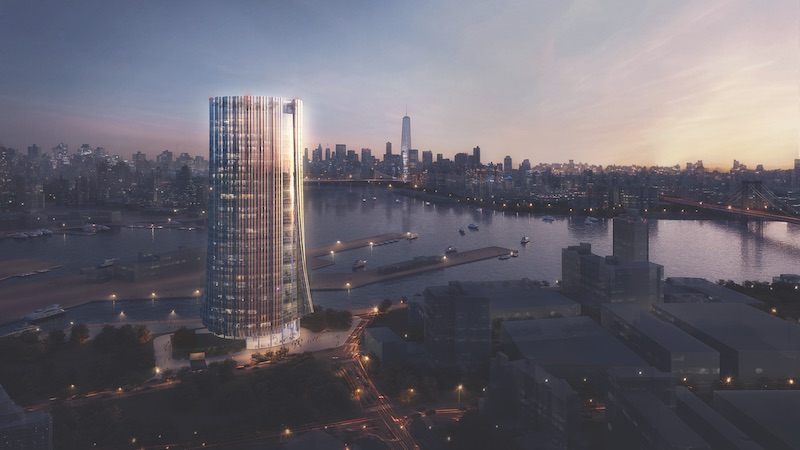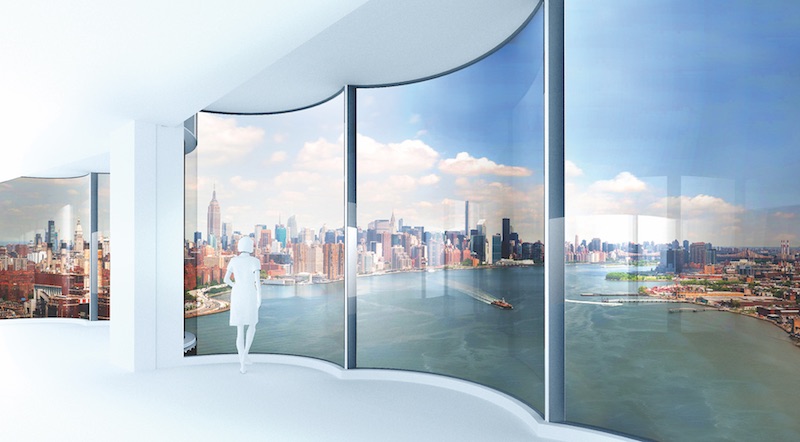New research by interior landscaping firm Ambius (bit.ly/2MPpiy3) found that the typical office worker spends less time outside than prisoners. According to the survey, 35% of office workers spend no more than 15 minutes outside during their day, and only 26% say they spend more than an hour outside each day.
For many office workers, especially those who work in skyscrapers, stepping outside for a break is easier said than done. Is there a way for these workers to feel connected to the outdoors and gain the benefits mother nature provides? HOK seems to think so.
The firm developed the Circadian Curtain Wall concept, which provides building occupants with bountiful natural light and minimizes solar heat gain. The idea was born from a project HOK façade specialist John Neary, AIA, LEED AP, was working on for a load-bearing façade for high-rise buildings. Much of the aluminum was replaced with steel for added strength; Neary evolved the concept by using curved glass, thus giving the building skin more strength and wind resistance.
 Courtesy HOK.
Courtesy HOK.
The curved, bubbled glass of the Circadian Curtain Wall allows building occupants to have wide-angled views of the outdoors while also bringing natural light deep into a building, keeping the occupants connected to the circadian rhythm of night and day.
See Also: Warehouses rise up to serve downtown
The bubbled windows can be combined with an ovoid floor plate to provide a more active benefit for the building and its occupants: external shading. Regardless of where the sun is in the sky, the bubbled windows reduce the surface area exposed to direct sunlight and provide shading to adjacent areas of the façade. At any given moment, a tower with the circadian curtain wall would be 75% self shaded. A equal-sized tower with a traditional rectangular footprint would only be 50% self shaded.
 Courtesy HOK.
Courtesy HOK.
Due to the windows’ convex nature, sunlight would only hit them at a right angle in a limited area, significantly reducing solar heat load. Some external shades would still be needed. In an effort to not spoil the views, Neary and his team proposed using automated shades stored in a ventilated six-inch cavity between an exterior piece of glass and insulated glazing on the interior of the building.
WSP Built Ecology conducted daylighting and energy model simulations and found the Circadian Curtain Wall can reduce energy use by 16%, peak cooling load by 24%, and peak heating load by 27% in a 30-story building.
Related Stories
AEC Tech Innovation | Mar 9, 2022
Meet Emerge: WSP USA's new AEC tech incubator
Pooja Jain, WSP’s VP-Strategic Innovation, discusses the pilot programs her firm’s new incubator, Emerge, has initiated with four tech startup companies. Jain speaks with BD+C's John Caulfield about the four AEC tech firms to join Cohort 1 of the firm’s incubator.
Great Solutions | Jan 18, 2022
Researchers develop concept for rechargeable cement-based batteries
Researchers from the Department of Architecture and Civil Engineering at Chalmers University of Technology in Gothenburg, Sweden, have created a concept for rechargeable batteries made of cement. The concept involves a cement-based mixture with small amounts of short carbon fibers added to increase conductivity and flexural toughness.
Great Solutions | Nov 22, 2021
Drywall robots take the risk out of the finishing process
Canvas is using robots to complement the work already being done by drywall professionals.
Great Solutions | Sep 23, 2021
Seattle looks to become America’s most walkable city with a new citywide wayfinding system
Seamless Seattle will support the Seattle Department of Transportation’s commitment to increase the percentage of trips made by walking to 35% by 2035.
Great Solutions | Jul 9, 2021
MojoDesk creates a new solution for managing open office distractions
The MojoDome allows for a private work space while also maintaining a collaborative environment.
Great Solutions | Mar 18, 2021
Follow the leader: New following technology better equips robots for the jobsite
New proof-of-concept from Piaggio Fast Forward and Trimble enables robots and machines to follow humans.
Great Solutions | Feb 11, 2021
Simplifying the return to the office
A new web-based tool from Sasaki takes the guesswork out of heading back to the workplace.
Great Solutions | Oct 6, 2020
Could water-filled windows help buildings save energy?
New research shows how water-filled glass could help heat and cool buildings.
Great Solutions | Aug 10, 2020
From lobby to penthouse, elevators can be a 100% touch-free experience
The Toe-To-Go elevator system allows riders to operate the elevator entirely with their feet.
Great Solutions | Jul 13, 2020
Essential protection for businesses
Custom protective barriers help keep essential business employees safe.

















